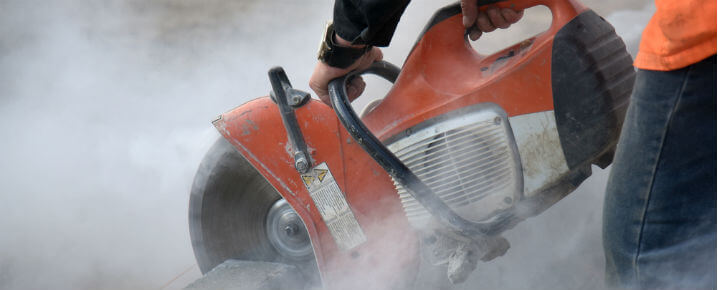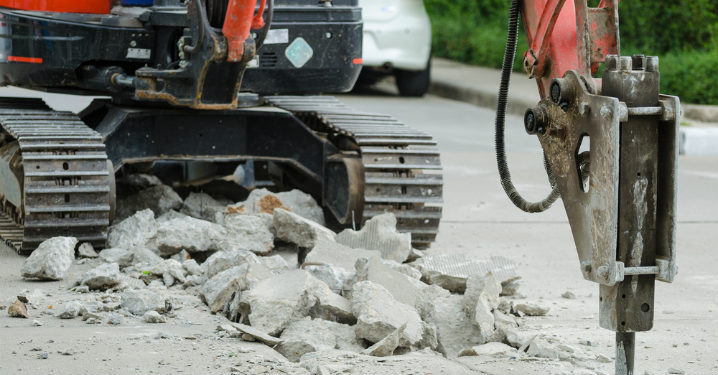Some serious silica-related diseases can result from exposure to respirable crystalline silica dust. In fact, that’s why the OSHA silica standard is in place.
Silica safety involves silica dust regulations and a designed silica protection plan. We’ll talk about both components today.
What Is Respirable Crystalline Silica?
The respirable crystalline silica standard defines this crystalline silica as a common mineral. It’s found in many construction materials. Things like stone, brick, sand, concrete, and mortar contain it. So, when workers crush, drill, grind, or cut these types of materials, they give way to dust particles. That’s the respirable silica we’re discussing here.
Dangers of Respirable Crystalline Silica Exposure
If it’s dust, that means we can breathe it in. These respirable particles can travel into workers’ lungs. This can lead to silicosis. Unfortunately, the disease is incurable. It can even be deadly. And the effects don’t stop there. This kind of silica exposure can also cause other respiratory diseases and even lung cancer.
It’s a big deal. It’s why the new OSHA silica dust rules are being implemented. Read this article in full for information regarding the new silica standard.

How Are Workers Exposed to Respirable Crystalline Silica?
Workers are exposed to respirable crystalline silica when they’re sandblasting. They’re removing paint and rust from buildings, bridges, tanks, etc.
Rock and well drilling, jackhammering, concrete mixing, and block and brick cutting/sawing can produce silica dust, too. If you’re laying or repairing railroad tracks or performing tunnel operations, you might be exposed.
Workers repairing or replacing the linings of furnaces and kilns could also breathe in dangerous particles.
New OSHA Silica Standard
In 2015, OSHA issued a hazard alert regarding silica dust. In 2016, OSHA silica guidelines included limits on how much silica could be in the air. And that’s what we follow today. Before the 2016 update, the regulations had not been altered since 1971.
As of now, the OSHA silica exposure standard 29 CFR 1926.1153 says employers should limit workers’ exposure to respirable crystalline silica. They may use control methods or measure individual workers’ exposure. They must decide which controls work for their specific environment.
What Is the PEL for Silica Dust?
PEL stands for “permissible exposure limit.” The new rule has lowered the OSHA silica PEL to 50 micrograms per cubic meter of air (based on an average 8-hour workday). Under this rule, employers are further required to limit access to high-exposure areas.
They must also develop a written silica exposure control plan, and provide respiratory protection for workers when the controls can’t adequately limit exposure. Employees must be offered medical examinations every 3 years if they wear respirators on the job. Records of these exams must be kept and maintained.
Finally, employers are responsible for providing training. Their workers should be educated on the types of activities that result in crystalline silica exposure and exactly how it can be limited.
Get in touch with Safety by Design today for further safety training services in Houston.
Table 1 Examples
Here, we’ll focus on the construction silica standard. Table 1 in the standard outlines specific exposure control methods when working with materials containing crystalline silica. Here are a few examples. Please refer to OSHA documentation for a comprehensive review.
Handheld Power Saws
There are different regulations for indoor and outdoor use. You must use a saw that continuously feeds water to the blade. Follow manufacturers’ guidelines to reduce dust emissions. When outdoors, you must employ an approved commercial dust collection system.
Dowel Drilling Rigs for Concrete
You must use a shroud around the drill bit and employ a dust collection system. Specific filters and cleaning methods are required, too.
Crushing Machines
Your equipment must be designed to deliver water spray or mist. This suppresses dust at the crusher discharge points. Manufacturers’ guidelines must be followed. And a ventilated booth that provides climate-controlled, fresh air should be used by the operator. They may also control using a remote station.

Alternative Control Methods
What happens if you do not fully implement the OSHA silica dust regulations in Table 1? You’re responsible for determining the amount of silica dust that your employees are exposed to. You must protect your workers. Use dust controls and safe work methods.
Finally, provide your workforce with respirators when controls and methods aren’t limiting exposure.
OSHA Silica Rule Effective Date
The process began in 2016. But new OSHA rules on silica exposure for the construction industry went into effect on September 23, 2017.
The general industry and maritime settings saw the standard take effect on June 23, 2018.
The oil and gas industry will see the rule in place on June 23, 2021.
OSHA fines for silica dust could cost you $304, 130. (That’s a grand total of the five possible violations.) Three of the five violations against your company would be willful-serious, which would constitute a hefty fine.
Contact Safety by Design for OSHA-Compliant Crystalline Silica Exposure Training
We’re knowledgeable and experienced when it comes to keeping you OSHA-compliant! Our safety consultant services cover the following topics:
- Health hazards regarding silica exposure
- Work tasks that can result in exposure
- Engineered controls, work practices, and respiratory equipment
- Specific sections of the new rule, pertinent to your industry
- Medical surveillance program
Contact Safety by Design today for the training you need.



